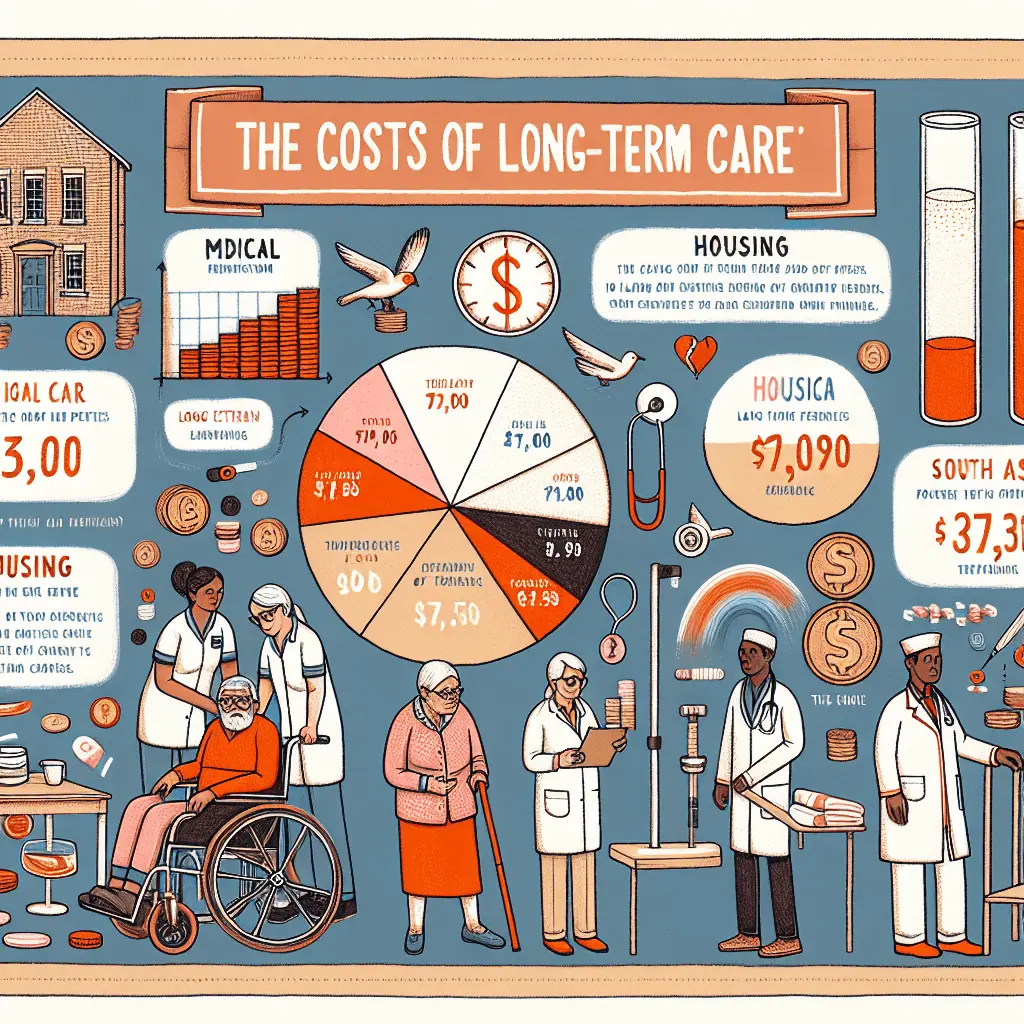Long Term Care Insurance
Long-term care insurance offers essential financial protection for those anticipating future long-term care needs. It guarantees peace of mind by covering expenses associated with extended care as individuals age. This specialized insurance serves as a critical component of thorough financial planning, safeguarding assets and providing financial security. By assessing personal requirements and customizing plans, individuals can choose policies that align with their preferences and budget. Exploring the intricacies of long-term care insurance policies and understanding the application process can further enhance the effectiveness of this important coverage. Discover more about the nuances of long-term care insurance for a well-informed decision.
Introduction long-term care insurance
Long-term care insurance (LTCI) offers a safety net for individuals planning for their future care needs. This type of insurance provides financial protection against the high costs of long-term care services, such as nursing home care or assistance with daily living activities. Understanding the significance of LTCI can help individuals secure their assets and guarantee peace of mind as they age.
Brief overview of long-term care insurance (LTCI)
Long-term care insurance, essential for safeguarding against the financial burden associated with extended healthcare needs in older age, offers individuals a vital approach to securing their future care requirements.
| Key Aspects | Description |
|---|---|
| Elder Care | Long-term care insurance provides coverage for the care needed as individuals age. |
| Financial Planning | It plays an important role in financial planning by covering the high costs of long-term care. |
| Retirement Planning | Helps individuals plan for their retirement by ensuring they have financial protection for potential healthcare needs. |
| Healthcare Coverage | Offers thorough coverage for various healthcare services required in older age. |
| Long-Term Care Insurance | Specifically designed to cover expenses related to long-term care needs. |
Importance of LTCI in planning for the future
Planning for future care needs becomes a critical aspect of financial preparedness as individuals age, underscoring the significance of Long-Term Care Insurance (LTCI) in ensuring thorough coverage and protection. LTCI plays a crucial role in safeguarding one’s financial stability and well-being during retirement by providing coverage for long-term care services, such as nursing home care or assisted living facilities. Additionally, incorporating LTCI into financial planning strategies can help mitigate the potentially high costs associated with long-term care needs, offering a sense of security and peace of mind for individuals and their families. Furthermore, LTCI can complement retirement planning efforts by ensuring that funds are allocated efficiently to cover future care requirements, thereby preserving assets and enhancing financial security.
Understanding Long-Term Care Insurance

Understanding Long-Term Care Insurance is essential for individuals looking to secure their financial future and guarantee they receive adequate care in their later years. This discussion will cover the definition and purpose of LTCI, highlighting its unique features compared to other health insurance types. Additionally, we will explore who would benefit from LTCI and why it is a valuable investment for long-term care planning.
Definition and purpose of LTCI
Providing coverage for specialized healthcare needs in later stages of life, Long-Term Care Insurance (LTCI) serves as a financial safeguard against the high costs associated with custodial and personal care services. LTCI is designed to assist individuals with activities of daily living (ADLs) or cognitive impairments that require long-term care. The primary purpose of LTCI is to provide policyholders with financial protection and peace of mind, ensuring they can afford necessary care without depleting their savings or assets. By offering extensive healthcare coverage tailored to long-term care needs, LTCI helps individuals maintain their independence and quality of life while managing the escalating costs of aging and chronic illnesses.
- Covers a range of long-term care services such as nursing home care, assisted living, and home health care.
- Helps individuals plan for future healthcare costs and protect their assets.
- Offers a safety net for policyholders facing extended periods of disability or chronic illness.
The difference between LTCI and other types of health insurance
Long-Term Care Insurance (LTCI) differs markedly from conventional health insurance policies due to its specialized coverage tailored specifically to long-term care needs. While health insurance provides coverage for a broader range of medical services and treatments, LTCI focuses on long-term care services such as custodial care, nursing home care, and assistance with daily living activities. Unlike Medicaid, which is a needs-based program, LTCI is a private insurance product that individuals purchase to cover long-term care expenses. Chronic care insurance, on the other hand, is designed to cover ongoing medical conditions, whereas LTCI is specifically designed for long-term care needs. Understanding these differences can help individuals make informed decisions about their healthcare coverage options.
Who needs LTCI and why
The distinction between Long-Term Care Insurance (LTCI) and other types of health insurance underscores the specific necessity for individuals to contemplate LTCI based on their long-term care needs.
- Individuals with substantial assets who wish to protect their wealth from being depleted by long-term care expenses.
- Those who do not have family members or relatives available to provide long-term care support.
- People who want to have control over their long-term care options and not be solely reliant on government assistance programs.
These reasons highlight the importance of long-term care planning and the role LTCI can play in providing financial security and peace of mind for individuals facing potential long-term care needs.
The Costs of Long-Term Care

Long-term care costs can be a significant financial burden for individuals and families, especially when considering expenses associated with nursing homes, assisted living facilities, or in-home care services. Long-Term Care Insurance (LTCI) serves as an essential financial tool in managing these costs by providing coverage for various long-term care services. Real-life examples illustrating the impact of long-term care costs and how LTCI can help mitigate these expenses will be explored in further detail.
Overview of long-term care costs without insurance
Costs associated with extended care services can present significant financial challenges to individuals and families who do not have insurance coverage for long-term care needs. Without insurance protection, individuals may face the following realities:
- High Healthcare Expenses: Long-term care costs can quickly deplete savings and assets.
- Financial Strain: Families may struggle to meet the financial demands of caregiving and healthcare services.
- Risk to Asset Preservation: The absence of insurance coverage puts assets at risk of being used to cover long-term care expenses, potentially impacting financial stability and inheritance plans.
How LTCI helps manage these costs
Utilizing Long Term Care Insurance (LTCI) can provide individuals and families with an essential financial safeguard against the substantial expenses associated with extended care services. LTCI helps manage costs by offering financial protection specifically tailored to cover long-term care needs. By investing in LTCI, individuals can effectively preserve their assets from being depleted by high healthcare expenses related to long-term care. This type of insurance safeguards that policyholders have assistance in covering the costs of various long-term care services, including nursing home care, assisted living facilities, and in-home care. By mitigating the financial burden through LTCI, individuals can secure their financial security and peace of mind, knowing that they have a plan in place to manage potential long-term care expenses effectively.
Real-life examples of long-term care costs
With the increasing prevalence of long-term care needs among the aging population, understanding the real-life examples of expenses associated with extended care services becomes imperative for individuals considering financial planning options. Here are three real-life examples showcasing the financial impact of long-term care costs:
- Case Study 1: An elderly individual requiring nursing home care for an extended period faced monthly expenses exceeding $8,000, notably impacting their retirement savings.
- Case Study 2: A couple needing in-home assistance with daily living activities incurred expenses of over $5,000 per month, highlighting the substantial care expenses associated with aging.
- Case Study 3: A person diagnosed with a chronic illness sought specialized care, leading to annual costs surpassing $100,000, emphasizing the significant financial burden long-term care can impose on individuals and families.
Key Features of Long-Term Care Insurance Policies

When considering long-term care insurance policies, it is important to understand the key features that determine coverage options, benefit triggers, benefit periods, daily benefit amounts, and inflation protection. Coverage options typically include in-home care, assisted living, and nursing home care, while benefit triggers specify the conditions that qualify an individual to receive benefits. Benefit periods and daily benefit amounts establish the duration and financial assistance provided, and inflation protection is vital for safeguarding against rising care costs over time.
Coverage options (e.g., in-home care, assisted living, nursing home care)
Long-term care insurance policies offer coverage options that encompass a range of care settings, including in-home care, assisted living facilities, and nursing home care.
- In-Home Care: This option allows individuals to receive care services in the comfort of their own homes. It can include assistance with activities of daily living such as bathing, dressing, and meal preparation.
- Assisted Living: Assisted living facilities provide a supportive environment for individuals who require assistance with daily tasks but do not need around-the-clock medical care. Residents typically have their own living spaces while receiving help with activities like medication management and housekeeping.
- Nursing Home Care: Nursing homes offer 24-hour skilled nursing care for individuals with significant medical needs or those who are unable to live independently. This option provides a higher level of care for those with complex health conditions.
Benefit triggers: What qualifies you to receive benefits
Benefit triggers in long-term care insurance policies are specific criteria or conditions that must be met to qualify for receiving benefits under the policy. These triggers typically include limitations in Activities of Daily Living (ADLs) or cognitive impairment. Qualification requirements may vary among insurance providers, and pre-existing conditions can also impact eligibility for benefits. The table below provides an overview of common benefit triggers in long-term care insurance policies:
| Benefit Triggers | Description | Examples |
|---|---|---|
| ADL Limitations | Inability to perform basic daily tasks independently | Bathing, dressing, eating |
| Cognitive Impairment | Decline in mental abilities affecting daily functioning | Memory loss, confusion |
| Qualification Requirements | Criteria that must be met to receive benefits | Physician certification, waiting period |
| Pre-existing Conditions | Medical conditions present before policy issuance | Diabetes, heart disease |
Benefit periods and daily benefit amounts
Key features of Long-Term Care Insurance Policies include specifying the duration of benefit periods and determining the daily benefit amounts provided to policyholders. When contemplating long-term care insurance policies, individuals should pay close attention to the following key aspects:
- Benefit Periods: Policyholders should understand the length of time for which benefits will be paid out, whether it is a set number of years, a lifetime benefit, or another specified period.
- Daily Benefit Amounts: The policy will outline the maximum amount that will be paid out each day for covered services, which can vary based on the policy chosen.
- Policy Premiums and Elimination Period: The cost of the policy premiums and the elimination period (waiting period before benefits begin) are essential factors to take into account when selecting a long-term care insurance policy.
Inflation protection: Why its important and how it works
Incorporating inflation protection into long-term care insurance policies is an essential strategy for ensuring the sustainability and adequacy of coverage over time. This feature adjusts the policy’s benefits in line with the rising costs of long-term care services, safeguarding the insured against the erosive effects of inflation. Without inflation protection, the purchasing power of the policy benefits may diminish over the years, potentially leaving the policyholder underinsured when they need care the most. By addressing this concern, policyholders can better secure their financial well-being and access the necessary care without concerns about escalating expenses. Inflation protection works by increasing the benefit payouts or coverage limits periodically, aligning them with the current cost of care, thereby providing a critical layer of asset protection and maintaining the policy’s value throughout its coverage duration.
Choosing the Right Long-Term Care Insurance Policy

When selecting a long-term care insurance policy, it is important to take into consideration various factors such as the impact of age and health on premiums and eligibility. Additionally, understanding the differences between group and individual policies can help in making an informed decision based on the pros and cons of each. Marital status is another aspect that can influence long-term care insurance choices, as it may affect coverage options and premiums.
Factors to consider when choosing a policy
Selecting the appropriate long-term care insurance policy requires a thorough assessment of individual needs and financial considerations. When choosing a policy, consider the following factors:
- Policy Type: Decide between traditional long-term care insurance and hybrid policies that combine long-term care coverage with life insurance or annuities.
- Benefit Triggers: Understand the conditions that must be met to start receiving benefits, such as limitations on activities of daily living (ADLs) or cognitive impairment.
- Coverage Duration: Choose between lifetime coverage or a fixed period, considering how long you anticipate needing care and your budget constraints.
Carefully evaluating these factors will help you select a policy that aligns with your long-term care needs while also providing financial security.
The impact of age and health on premiums and eligibility
Age and health are critical factors that greatly influence the premiums and eligibility criteria for securing an appropriate long-term care insurance policy. As individuals age, the risk of requiring long-term care increases, leading to higher premiums. Additionally, an individual’s current health status plays a significant role in determining their eligibility for certain policies and the cost of premiums. Below is a table illustrating the impact of age and health on premiums and eligibility:
| Factor | Impact on Premiums | Impact on Eligibility |
|---|---|---|
| Age | Increases premiums as age rises | May affect eligibility for certain policies |
| Health | Poor health can lead to higher premiums | Could impact eligibility for coverage |
Understanding how age and health influence long-term care insurance can help individuals make informed decisions when selecting a policy.
Group vs. individual policies: Pros and cons
Group and individual long-term care insurance policies each offer distinct advantages and disadvantages that individuals should carefully consider when making their insurance decisions. When comparing group and individual policies, individuals should weigh the following factors:
- Coverage Options:
- Group Long Term Care Insurance: Often has limited coverage options that may not cater to individual needs.
- Individual Long Term Care Insurance: Allows for more customized coverage options tailored to specific requirements.
- Policy Customization:
- Group Long Term Care Insurance: Limited ability to customize policies to fit personal preferences.
- Individual Long Term Care Insurance: Offers greater flexibility in policy customization to align with individual preferences and needs.
- Pros and Cons:
- Group Long Term Care Insurance: Generally more affordable due to group rates but may lack flexibility.
- Individual Long Term Care Insurance: Provides more customization but can be costlier.
How marital status affects LTCI
Marital status plays a pivotal role in determining the most suitable long-term care insurance policy for individuals and their spouses. When considering long term care insurance for couples, spousal riders can be valuable additions to make sure both partners are covered adequately. Benefit triggers, such as ADL limitations, are essential in activating the policy’s benefits when assistance with daily living activities is required. For couples engaging in Medicaid planning, understanding how marital status affects eligibility and benefits is important for financial security. Long-term care insurance can provide peace of mind by offering coverage tailored to the specific needs of both spouses, ensuring they are protected in the event of chronic illness or disability while also considering their joint financial future.
Financial Considerations

When evaluating long-term care insurance, it is essential to understand the financial implications involved. This includes examining the average costs of LTCI premiums based on age and gender, exploring strategies to afford these premiums, and being aware of the tax implications and benefits associated with LTCI. Financial considerations play a significant role in determining the feasibility and sustainability of long-term care insurance coverage.
Average costs of LTCI premiums by age and gender
The average costs of Long-Term Care Insurance (LTCI) premiums vary considerably based on age and gender, reflecting the financial considerations that individuals need to carefully assess when planning for long-term care needs.
- Age Factors: Younger individuals typically pay lower premiums for LTCI compared to older individuals due to the lower perceived risk of requiring long-term care at a younger age.
- Gender Disparities: Women often pay higher LTCI premiums than men due to their longer life expectancy and higher likelihood of needing long-term care services.
- Combined Policies: Some insurance companies offer joint policies for couples, which can provide a discounted premium rate compared to two separate individual policies.
Strategies for affording LTCI premiums
Considering the financial implications of Long-Term Care Insurance (LTCI) premiums, what strategic approaches can individuals adopt to make this essential coverage more affordable? Affording LTCI premiums requires careful financial planning. One strategy is to start early and purchase a policy when younger to benefit from lower premiums. Another approach is to opt for a shorter benefit period or longer elimination period to reduce costs. Individuals can also explore premium payment strategies such as annual payments or selecting a limited payment period. Taking advantage of discounts for married couples or shared policies can also help in affording premiums. Additionally, reviewing and adjusting coverage as financial situations change can make certain the policy remains affordable while providing adequate long-term care insurance protection.
Tax implications and benefits of LTCI
Exploring the tax implications and benefits of Long-Term Care Insurance (LTCI) is essential for individuals seeking thorough financial planning strategies. When considering LTCI, it is vital to understand the following:
- Tax Implications: LTCI premiums may be tax-deductible, offering potential tax benefits to policyholders.
- Asset Protection: LTCI can help protect assets by covering long-term care costs, reducing the financial burden on individuals and their families.
- Financial Security: By providing coverage for long-term care needs, LTCI offers individuals peace of mind and financial security during times of illness or incapacity.
Alternatives and Supplements to Long-Term Care Insurance

In considering alternatives to Long-Term Care Insurance, individuals can explore hybrid policies that combine LTCI with life insurance or annuities, as well as short-term care insurance tailored to specific needs. Additionally, understanding the limitations of government programs like Medicaid and Medicare is essential when evaluating supplementary options for long-term care coverage. By examining these alternatives and supplements, individuals can make informed decisions to protect their financial well-being and healthcare needs in the future.
Hybrid policies: Combining LTCI with life insurance or annuities
Hybrid policies that merge long-term care insurance with life insurance or annuities offer a holistic approach to financial planning for potential long-term care needs. These policies provide a unique blend of benefits that cater to both long-term care requirements and financial security. Here are three key aspects to keep in mind:
- Combined Coverage: Hybrid policies offer coverage for long-term care needs as well as a death benefit or annuity component, providing a complete solution for policyholders.
- Asset Protection: By combining long-term care insurance with life insurance or annuities, individuals can safeguard their assets against the high costs of long-term care services.
- Flexible Payout Options: These policies often offer flexible payout options, allowing policyholders to tailor the benefits to their specific needs and preferences.
Short-term care insurance: What it covers and who its for
Merging long-term care insurance with life insurance or annuities through hybrid policies provides a thorough financial strategy, but for those seeking alternatives or supplements, short-term care insurance offers a focused solution tailored to specific needs. Short-term care insurance typically covers temporary care needs resulting from an illness, injury, or recovery from a medical procedure. It provides benefits for a limited duration, usually up to 12 months, and can be an option for individuals who do not require long-term care but need assistance for a short period. However, short-term care insurance may have limitations such as lower benefit amounts and stricter qualifications compared to traditional long-term care insurance. Below is a table highlighting key aspects of short-term care insurance:
| Aspects | Details |
|---|---|
| Coverage | Temporary care needs |
| Benefits | Limited duration, up to 12 months |
| Limitations | Lower benefit amounts, strict qualifications |
Government programs and their limitations (Medicaid and Medicare)
Exploring government programs such as Medicaid and Medicare provides valuable insights into potential alternatives and supplements to traditional long-term care insurance for individuals seeking all-encompassing healthcare coverage.
- Medicaid is needs-based, offering coverage for long-term care services for individuals with limited financial resources.
- Medicare provides limited coverage for skilled nursing care under specific conditions, such as after a hospital stay.
- Both programs have limitations, including strict eligibility criteria and coverage restrictions, making them supplemental options rather than all-embracing long-term care insurance solutions.
Understanding the nuances of these government programs is important for individuals planning their long-term care needs and seeking financial protection against healthcare costs.
Navigating the Application Process
As individuals begin the application process for Long Term Care Insurance (LTCI), comprehending the necessary steps is essential. From filling out the application form to going through medical underwriting, each stage demands attention to detail. Tips for a successful application, such as revealing pre-existing conditions transparently, can greatly influence the outcome of the process.
Steps to apply for LTCI
Effectively navigating the application process for Long Term Care Insurance involves collecting necessary documentation, completing the required forms accurately, and understanding the underwriting procedures. To apply for LTCI, follow these steps:
- Eligibility Criteria: Review the specific requirements set by the insurance provider to make certain you meet the qualifications for coverage.
- Required Documentation: Prepare documents such as medical records, proof of income, and personal identification for submission with your application.
- Application Submission: Fill out the application form carefully, providing all requested information truthfully and promptly submit it to the insurer for review.
Medical underwriting and pre-existing conditions
Upon submitting the necessary documentation for Long Term Care Insurance application, individuals may encounter the process of medical underwriting and considerations regarding pre-existing conditions. Medical underwriting involves the insurance company evaluating the applicant’s health status to determine insurability and set policy premiums. Pre-existing conditions are existing health issues that the individual has before applying for long-term care insurance. These conditions can impact the qualification requirements, policy terms, and premium costs. Insurers may require additional information or medical exams for applicants with pre-existing conditions to evaluate the level of risk involved. Understanding how medical underwriting and pre-existing conditions affect long-term care insurance applications is vital for individuals seeking coverage tailored to their needs and financial circumstances.
Tips for a successful application
Exploring the application process for long-term care insurance requires careful attention to detail and thorough preparation to guarantee a successful outcome. When applying for long-term care insurance, consider the following key tips:
- Understand Qualification Requirements: Familiarize yourself with the eligibility criteria set by insurance providers to make sure you meet the necessary qualifications for the policy.
- Review Benefit Triggers: Be aware of the benefit triggers that activate the policy payouts, such as limitations in Activities of Daily Living (ADLs) or cognitive impairment, to ensure you grasp when you can make a claim.
- Manage Policy Premiums: Evaluate different policy premiums offered by various insurers to find a balance between affordability and all-inclusive coverage, ensuring financial stability while meeting your long-term care needs.
Managing Your Long-Term Care Insurance Policy
When it comes to managing your long-term care insurance policy, understanding how to file a claim when care is needed, making adjustments to your policy based on evolving needs, and knowing the steps to take if your premiums increase are essential aspects to take into account. Being prepared and informed about these key points can help policyholders navigate the complexities of their long-term care insurance coverage effectively and guarantee they receive the necessary support when the time comes. By proactively managing your policy, you can better prepare for any potential long-term care needs and make informed decisions to protect your financial well-being.
How to file a claim when you need care
When needing to access care covered under your Long-Term Care Insurance policy, understanding how to properly file a claim is essential for a seamless process. Here are three key steps to help you navigate the claims process effectively:
- Contact Your Insurance Company: Notify your insurance provider about the need for care and inquire about the specific documentation required for filing a claim.
- Gather Necessary Documents: Collect all relevant paperwork, such as medical records, care provider invoices, and any other supporting documentation needed to substantiate the care received.
- Submit Your Claim: Fill out the claim form accurately, attach the required documents, and submit everything to your insurance company promptly to initiate the claims process and receive the necessary assistance.
Adjusting your policy as your needs change
In order to guarantee that your Long-Term Care Insurance policy stays aligned with your evolving needs, regular reviews and adjustments are recommended to optimize coverage and benefits. As your circumstances change, such as changes in health or living situation, it is essential to assess if your policy adequately meets your requirements. Understanding the benefit triggers of your long-term care insurance, such as limitations on Activities of Daily Living (ADLs) or Cognitive Impairment, can help you determine when to adjust your policy. Policy flexibility is vital in accommodating changing needs; hence, working with your insurance provider to explore options for modifying your coverage can ensure that you have the necessary protection in place for your long-term care needs.
What to do if your premiums increase
To effectively manage your Long-Term Care Insurance policy, addressing any increases in premiums is a key aspect that may require attention as part of maintaining your coverage in line with your evolving needs. When faced with a premium increase, consider the following steps:
- Review Your Policy: Understand why the premiums are increasing by reviewing your policy documents and contacting your insurance provider for clarification.
- Assess Your Options: Evaluate if there are alternative policy options available that could better suit your budget while still meeting your long-term care needs.
- Consult a Financial Advisor: Seek advice from a financial planner to incorporate the increased cost of care into your overall financial planning strategy and explore potential adjustments.
The Future of Long-Term Care Insurance

Looking ahead, the future of long-term care insurance is poised for evolution as the market adapts to changing trends and demands. Innovations in both long-term care services and insurance products are expected to shape the landscape of LTCI offerings. Understanding these trends and advancements will be vital for individuals seeking to secure their future care needs.
Trends in the LTCI market
Given the evolving landscape of long-term care insurance (LTCI), significant shifts in market trends are shaping the future of the industry.
- Increased Focus on Hybrid Policies: The market is witnessing a rise in hybrid policies that combine long-term care benefits with life insurance or annuities, providing consumers with more flexible options.
- Customized Policy Features: Insurers are offering more customizable policy features to cater to diverse consumer preferences, such as adjustable benefit amounts, elimination periods, and inflation protection riders.
- Technology Integration: The industry is embracing technology to streamline processes, improve customer experience, and enhance underwriting accuracy, reflecting a shift towards modernizing traditional LTCI products.
Innovations in long-term care and insurance products
The evolving landscape of long-term care insurance (LTCI) is witnessing a notable shift towards innovative products and solutions aimed at enhancing the overall coverage and benefits provided to consumers. One significant innovation is the introduction of hybrid policies, which combine long-term care coverage with life insurance or annuities. These policies offer asset protection by providing benefits for long-term care needs while also offering a death benefit or cash value. Additionally, new benefit triggers such as cognitive impairment have been introduced to cater to a wider range of policyholders’ needs. Spousal riders are another innovative feature that allows couples to purchase coverage together, often at a discounted rate, ensuring both partners are protected. These advancements in long-term care insurance products reflect a commitment to meeting the evolving needs of policyholders.
Frequently Asked Questions
Can Long-Term Care Insurance Cover the Cost of Home Modifications for Aging in Place?
Long-term care insurance may cover home modifications for aging in place, aiding independence and safety. These changes can include handrails, ramps, and bathroom modifications. Consult your policy for specific coverage details and requirements.
Is Long-Term Care Insurance Portable if I Move to a Different State or Country?
Long-term care insurance portability across state or international borders varies by policy terms and regulations. It is essential to review your specific coverage details and consult with your insurance provider to understand any limitations or requirements.
How Does Long-Term Care Insurance Work With Other Types of Insurance, Such as Medicare or Disability Insurance?
Long-term care insurance supplements Medicare and disability insurance by covering custodial care and other services not typically included. It helps manage expenses for extended care needs, offering a layer of financial protection.
Are There Any Tax Implications for Long-Term Care Insurance Premiums or Benefits?
Tax implications for long-term care insurance premiums or benefits depend on various factors, including if the policy qualifies for tax deductions or if benefits are taxable. Consult a tax professional to understand how your specific situation may be impacted.
Can Long-Term Care Insurance Be Used to Pay for Respite Care for Family Caregivers?
Respite care for family caregivers is essential for rejuvenation and well-being. It provides temporary relief and support, allowing caregivers to rest and recharge, ultimately enhancing the quality of care provided to their loved ones.
Conclusion
In summary, Long-Term Care Insurance (LTCI) plays a vital role in thorough financial planning, offering individuals a way to safeguard their assets and guarantee their long-term care needs are met. It is essential for individuals to carefully assess their personal requirements and thoroughly explore the various LTCI options available to make informed decisions that align with their financial goals and healthcare needs. By understanding the significance of LTCI and taking proactive steps to secure appropriate coverage, individuals can enhance their financial security and peace of mind for the future.
Recap of the importance of LTCI in comprehensive financial planning
Long-term care insurance plays a pivotal role in thorough financial planning, providing essential protection and peace of mind for individuals seeking to safeguard their assets against the potential high costs associated with long-term care services.
- Asset Protection: LTCI helps protect savings and assets from being depleted by long-term care expenses.
- Financial Security: It guarantees individuals have a financial plan in place to cover potential long-term care needs.
- Peace of Mind: By having LTCI, individuals can feel confident knowing they have a safety net for their long-term care requirements.
These factors highlight the importance of incorporating LTCI into a detailed financial plan to better prepare for future healthcare needs.
Encouragement to evaluate personal needs and explore LTCI options
Integrating long-term care insurance into a comprehensive financial plan ensures individuals are well-prepared for potential healthcare needs, highlighting the importance of evaluating personal requirements and exploring available LTCI options. Encouraging a review of personal needs serves as a crucial initial step in determining the level of coverage necessary to protect against future long-term care costs. By thoroughly examining factors such as age, health status, family history, and financial situation, individuals can customize their LTCI plans to meet their specific needs. In addition, exploring the diverse range of LTCI options enables individuals to choose policies that align with their preferences and budgetary constraints. This proactive approach not only provides financial security but also offers peace of mind knowing that sufficient coverage is in place for any unexpected long-term care needs.










